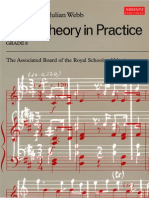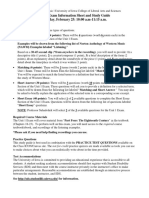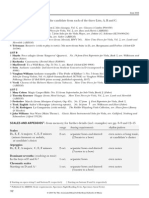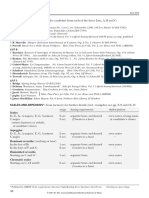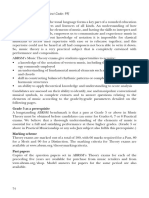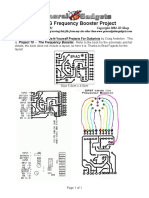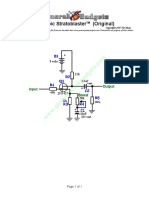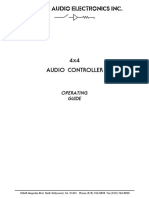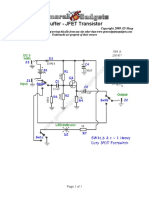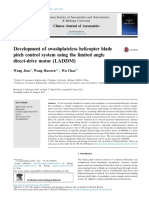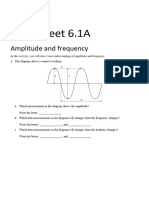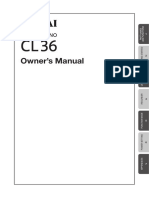Graduate Entrance Exam: Description and Study Guide
Graduate Entrance Exam: Description and Study Guide
Uploaded by
大石 真義Copyright:
Available Formats
Graduate Entrance Exam: Description and Study Guide
Graduate Entrance Exam: Description and Study Guide
Uploaded by
大石 真義Original Description:
Original Title
Copyright
Available Formats
Share this document
Did you find this document useful?
Is this content inappropriate?
Copyright:
Available Formats
Graduate Entrance Exam: Description and Study Guide
Graduate Entrance Exam: Description and Study Guide
Uploaded by
大石 真義Copyright:
Available Formats
SC HOOL OF MUSIC AND DANCE
Music Graduate Office
(541) 346-5664 • gradmus@uoregon.edu • music.uoregon.edu
Graduate Entrance Exam:
Description and Study Guide
A two-hour entrance examination in music history and a two-hour entrance examination in
music theory and aural skills are required of all graduate students before their first term of
enrollment. The examination is given before the beginning of each term. Students who score
below the designated levels must enroll in a prescribed course or courses at the first
opportunity (review courses are offered in the fall and summer terms of each year).
Music History
Part One
Listening
Ten listening examples will be played twice (each approximately 30–90 seconds in
length). For each example, identify a probable or likely composer, a fifty-year span
during which the example could have been composed (e.g., 1875–1925, 1700–1750), and
a probable title, form or genre as far as it may be evident. (30 points)
Part Two
Short-Answer Questions
1. Nine musical terms will be listed (e.g., the term madrigal). You are to (1) describe
each term as it applies to music and (2) name a specific stylistic period or periods
associated with the term. (18 points)
2. Ten composers will be listed. Name the style period and nationality generally
associated with each composer. (20 points)
Part Three
Essay
You will be asked to write on one essay question from a selection of four (e.g., discuss the
main developments in opera from its beginnings to Wagner) (20 points). PhD students
with a primary area in musicology will choose two essay questions. (40 points total)
Part Four
Score Recognition
Three excerpted scores will be provided. Give a likely composer, approximate date of
composition (within the limits specified on the listening portion of the exam), possible
genre, and one reason for your answer. (12 points)
Suggested Study Materials for Exam Preparation
Music history textbooks such as:
J. Peter Burkholder, Donald J. Grout and Claude V. Palisca, A History of Western Music, 7th
edition. (N.Y.: Norton, 2005).
Richard Crawford, America's Musical Life: A History (N.Y.: Norton, 2003).
Sarah Fuller, The European Musical Heritage, 800-1750, revised edition (Boston: McGraw Hill,
2006).
Donald J. Grout and Claude V. Palisca, A History of Western Music, 6th edition (N.Y.: Norton,
2001).
H. Wiley Hitchcock, Music in the United States: A Historical Introduction (Englewood Cliffs,
N.J.: Prentice-Hall, 1974).
David Poultney, Studying Music History: Learning, Reasoning, and Writing About Music
History and Literature, 2nd edition (Upper Saddle River, N.J: Prentice Hall, 1996).
K. Marie Stolba, The Development of Western Music, 3rd edition (Boston: McGraw Hill, 1998).
Anthologies of Western music and recorded anthologies of Western music such as:
Norton Anthology of Western Music, 2 vols, 4th edition, edited by Claude V. Palisca, and The
Norton Recorded Anthology of Western Music, 2 vols, 4th edition, edited by Claude V.
Palisca (N.Y.: Norton, 2001).
The Norton Anthology of Western Music and The Norton Recorded Anthology, 5th edition,
edited by J. Peter Burkholder. (N.Y.: Norton, 2005);
K. Marie Stolba, The Development of Western Music: An Anthology, 2 vols. 3rd edition
(Boston: McGraw Hill, 1998); Compact Discs, vol. 1-2 for use with The Development of
Western Music: An Anthology, 2 vols. 3rd edition (Boston: McGraw Hill, 1998).
Music Theory and Aural Skills
Part One, Aural Skills
A. Melodic Dictation (20 points)
A melody of moderate difficulty (diatonic with large skips) will be performed five
times by the instructor at the piano. Clef and key will be given (i.e. “Eb major,” but
not time signature or starting pitch. The student will determine the meter and starting
note, and notate the melody correctly.
B. Singing a Melody at Sight (tested individually, 30 points)
The notation of a melody will be given. After one minute of preparation and a
reference pitch from the piano, the student is asked to sing the melody.
Note: in this exercise, the melodies are not necessarily from a familiar repertory, but
are equivalent in their level of complexity.
A typical example:
Page 2 Graduate Entrance Exam Study Guide
C. Harmonic Dictation/Identifying Chords in Context (50 points)
A short, chordal excerpt from a piano sonata will be played three times. The student
will be given the notation of the excerpt’s rhythm, with certain notes numbered:
1 2 4 5 6 7 8 etc.
The first and third playings of the excerpt will be in a regular tempo (about MM=60),
but on the second hearing the instructor will pause on the numbered chords. The
student is asked to identify those chords by Roman numeral and inversion, or
alternatively by lead-sheet symbols with “slash-chord notation” indicating the bass
note (e.g. G7/B).
The vocabulary of chords includes the following: diatonic triads and seventh chords
(including the fully-diminished seventh chord) and secondary dominants, dominant
sevenths, and diminished sevenths of all scale degrees (V/ii, V7/iii, viio7/V, etc.). Any
chord may appear in inversion, and there may be a simple modulation to a closely
related key.
Part Two, Concepts
A. Analysis (65 points).
An excerpt from a string quartet will be given in score. Five of the chords and five of
the non-harmonic (non-chord, complementary) tones will be marked with numbers.
The student is asked to identify the chords by Roman numeral, and the non-harmonic
tones by type. Some non-harmonic tone types that could occur include the following:
Passing tone Upper neighbor Suspension
Escape tone (incomplete neighbor) Appoggiatura (incomplete N) Rearticulated suspension
In addition, a schematic representing the measures of the excerpt will be given:
1 5 10 15
| | | | | | | | | | | | | | | | etc.
The student will be asked to mark the excerpt’s phrases on this schematic with
brackets or arches, and to identify each phrase’s cadence as authentic (V-I), plagal (IV-
I), half (x-V) or deceptive (V-vi).
B. Harmonization/Figured Bass Realization (35 points)
A short four-part writing exercise will be given (four measures), in which the first half
consists of a melody, and the second half is a bass line with figures representing the
intervals above the bass. (The figures use the standard shorthand taught in
undergraduate theory courses—a blank space represents the root position triad, 6
represents first inversion, 7 a root position seventh chord, etc.). The student will be
Graduate Entrance Exam Study Guide Page 3
asked to harmonize the melody in four parts (including choosing appropriate chords),
and realize the figured bass in four parts (the chords will be indicated by the figures). It
is important for the student to follow proper voice-leading principles in this exercise:
avoiding parallel fifths and octaves, resolving active tones in the right direction, and
doubling and spacing chords correctly.
Suggested study materials for exam preparation
Some textbooks/exercises that could be useful in preparing for the theory entrance exam:
Aural Skills (melodic dictation and sight singing): Robert Ottman, Music for Sight Singing
Aural Skills (harmonic): find a repertory of chordal music (any traditional Protestant
hymn book will suffice—not one of the more recent ones), and have another student
play you excerpts, stopping on certain chords after the first hearing and asking you to
identify them.
Concepts: Stefan Kostka and Dorothy Payne, Tonal Harmony, Edward Aldwell and Carl
Schachter, Harmony and Voice Leading, or Elizabeth West Marvin and Jane
Clendinning, The Musician’s Guide to Theory and Analysis
[Study Guide Ent Exam.doc • Revised 05/05]
Page 4 Graduate Entrance Exam Study Guide
You might also like
- Gingerbread Boy PDFDocument2 pagesGingerbread Boy PDFכלבלב הו בידיבםבם100% (7)
- Tchaikovsky Serenade For Strings AnalysisDocument3 pagesTchaikovsky Serenade For Strings AnalysisConsuelo BolioNo ratings yet
- ABRSM - Music Theory in Practice GR 8 (1993)Document144 pagesABRSM - Music Theory in Practice GR 8 (1993)Viktor Casual93% (46)
- Juilliard TheoryDocument8 pagesJuilliard TheoryOsmar Arreortúa MariscalNo ratings yet
- Jazz Piano Patterns Essential Jazz Piano PhrasesDocument6 pagesJazz Piano Patterns Essential Jazz Piano PhrasesJohanWrapper94% (33)
- BOOKS by JERRY COKER 2Document4 pagesBOOKS by JERRY COKER 2Randerson Alex Gama Luz0% (1)
- RockschoolGmqDrums PDFDocument4 pagesRockschoolGmqDrums PDFNando Gonsales AbrilesNo ratings yet
- Bogner Ecstasy SchematicDocument1 pageBogner Ecstasy Schematic大石 真義100% (1)
- 1B 4 Chord Symbols and Harmonic Analysis PDFDocument4 pages1B 4 Chord Symbols and Harmonic Analysis PDFDman100% (1)
- Trauermarsch, Mahler's 5th, I, by Jody NagelDocument9 pagesTrauermarsch, Mahler's 5th, I, by Jody NagelHamid Alipour ShiraziNo ratings yet
- Music Curriculum Map Grade 1Document16 pagesMusic Curriculum Map Grade 1Maria Eberlyn DogaNo ratings yet
- Physics 6Document25 pagesPhysics 6Jo Ces50% (2)
- Graduate Entrance Exam: Description and Study GuideDocument10 pagesGraduate Entrance Exam: Description and Study Guidedaniel cNo ratings yet
- Unit 1 Exam - Study GuideDocument3 pagesUnit 1 Exam - Study GuideMackenzie HansenNo ratings yet
- MT1 KS5 Edexcel A2 Instrumental 2011Document18 pagesMT1 KS5 Edexcel A2 Instrumental 2011Alison Cooper-WhiteNo ratings yet
- Music 1b Final Exam ReviewDocument4 pagesMusic 1b Final Exam ReviewAllen YuanNo ratings yet
- StudyDocument2 pagesStudyCharlesNo ratings yet
- Unit Plan - 8th Grade Chorus Fall ConcertDocument11 pagesUnit Plan - 8th Grade Chorus Fall Concertapi-546827978No ratings yet
- T2 Form & StructureDocument17 pagesT2 Form & StructureAlexandraLehmannNo ratings yet
- Music HLSL MarkschemeDocument8 pagesMusic HLSL MarkschemeGurjot PersonalNo ratings yet
- Edtpa Task 1 B Lesson PlansDocument13 pagesEdtpa Task 1 B Lesson Plansapi-303160556No ratings yet
- BA PractialTheoryExam JazzDocument3 pagesBA PractialTheoryExam JazzBurakCihangirliNo ratings yet
- Horn GRADE 7Document2 pagesHorn GRADE 7xaviergeorgeNo ratings yet
- Music Theory and Aural Training (Minors)Document2 pagesMusic Theory and Aural Training (Minors)IggNo ratings yet
- Entrance Examination in Theory (For All Departments - Except Musicology)Document11 pagesEntrance Examination in Theory (For All Departments - Except Musicology)jonathanNo ratings yet
- MTC 223 Syllabus 2018Document15 pagesMTC 223 Syllabus 2018Vaibu MohanNo ratings yet
- MUSI 112 Listening To Music Professor Craig WrightDocument5 pagesMUSI 112 Listening To Music Professor Craig WrightChristian SotoNo ratings yet
- Modern Music InstituteDocument40 pagesModern Music Institutexalba14No ratings yet
- MUS342 Final Exam Study Guide SP2023Document5 pagesMUS342 Final Exam Study Guide SP2023Lucy FNo ratings yet
- MHL 204 - Exam 1 Review - 2016Document5 pagesMHL 204 - Exam 1 Review - 2016joefreak9000No ratings yet
- Beginning Band Scherzo LessonDocument4 pagesBeginning Band Scherzo Lessonapi-250999309No ratings yet
- Baritoneeuphonium0513 PDFDocument2 pagesBaritoneeuphonium0513 PDFLen CumminsNo ratings yet
- Music Theory Graduate Diagnostic Exam Review: Aural SkillsDocument2 pagesMusic Theory Graduate Diagnostic Exam Review: Aural SkillsShin-ChuangYuNo ratings yet
- Theory Study Guide 2017Document2 pagesTheory Study Guide 2017amcooper43No ratings yet
- Baritone Euphonium 0813Document3 pagesBaritone Euphonium 0813Oluwaseun Emmanuel IdowuNo ratings yet
- O Level Music 6053 2009Document24 pagesO Level Music 6053 2009winwarrior100% (10)
- Lesson Plan - Paul DDocument6 pagesLesson Plan - Paul DPaul Discipulo PatronNo ratings yet
- Music History Placement Exam Preparation Guide 03.08.21Document3 pagesMusic History Placement Exam Preparation Guide 03.08.21q75t2488q4No ratings yet
- Violin0416 PDFDocument2 pagesViolin0416 PDFpetruspolNo ratings yet
- ABRSM TheorycompleteDocument4 pagesABRSM TheorycompleteOdia Etinosa Julius20% (5)
- IB Music Revision Guide 2nd Edition: Everything you need to prepare for the Music Listening Examination (Standard and Higher Level 2016-2019)From EverandIB Music Revision Guide 2nd Edition: Everything you need to prepare for the Music Listening Examination (Standard and Higher Level 2016-2019)No ratings yet
- Exemplar Essays: Essay 1Document4 pagesExemplar Essays: Essay 1sablake12No ratings yet
- MT0818 Scheme KS5 Music For MediaDocument8 pagesMT0818 Scheme KS5 Music For MediaLucaNo ratings yet
- ABRSM Piano Grade 1 SyllabusDocument2 pagesABRSM Piano Grade 1 Syllabus*_niomi_*No ratings yet
- Chamber Music Literature and Repertoire 2 FinalDocument7 pagesChamber Music Literature and Repertoire 2 FinalAmín CarrilloNo ratings yet
- Trumpet, Cornet, Flugelhorn GRADE 8Document3 pagesTrumpet, Cornet, Flugelhorn GRADE 8Okiki GideonNo ratings yet
- Handel - Movement Vi From Water Music Suite Teacher NotesDocument14 pagesHandel - Movement Vi From Water Music Suite Teacher NotesAgostef100% (1)
- The University of Central Arkansas Department of Music Graduate Diagnostic Exam Study GuideDocument2 pagesThe University of Central Arkansas Department of Music Graduate Diagnostic Exam Study GuideAbner SantanaNo ratings yet
- As Handbook 1Document12 pagesAs Handbook 1api-278319614No ratings yet
- ZP OI Basstuba BA-EnglischDocument2 pagesZP OI Basstuba BA-EnglischBoth BélaNo ratings yet
- Audition RepertoireDocument8 pagesAudition Repertoiremh5959No ratings yet
- Viola ABRSMDocument3 pagesViola ABRSMAurora del RíoNo ratings yet
- Viola GRADE 3: THREE PIECES: One Chosen by The Candidate From Each of The Three Lists, A, B and CDocument3 pagesViola GRADE 3: THREE PIECES: One Chosen by The Candidate From Each of The Three Lists, A, B and CtantenoteNo ratings yet
- 8 Grade General MusicDocument6 pages8 Grade General MusicAde SherineNo ratings yet
- Ear Training: Entrance Requirements Theoretical Courses in GeneralDocument2 pagesEar Training: Entrance Requirements Theoretical Courses in GeneralMiguel Ángel ApodacaNo ratings yet
- AP Music Theory SyllabusDocument10 pagesAP Music Theory SyllabusBrianNo ratings yet
- Piano0715 PDFDocument3 pagesPiano0715 PDFSanjay ShresthaNo ratings yet
- ABRSM Cello RequirementsDocument3 pagesABRSM Cello RequirementsENo ratings yet
- MUSI 203 Oral Presentation GuideDocument2 pagesMUSI 203 Oral Presentation GuideJoseph HasperNo ratings yet
- Basic 7 Music 2ND Term E-Note 2017 EditionDocument38 pagesBasic 7 Music 2ND Term E-Note 2017 Editionpalmer okiemuteNo ratings yet
- ABRSM Music Theory Syllabus For Grade ExamsDocument4 pagesABRSM Music Theory Syllabus For Grade Examsvani100% (2)
- Anzca Associate Performer DiplomaDocument3 pagesAnzca Associate Performer DiplomamalcovishesNo ratings yet
- Shostakovich Symphony No. 10 2nd MovementDocument14 pagesShostakovich Symphony No. 10 2nd MovementIvan TorresNo ratings yet
- IB Music Revision Guide, 3rd Edition: Everything you need to prepare for the Music Listening Examination (Standard and Higher Level 20192021)From EverandIB Music Revision Guide, 3rd Edition: Everything you need to prepare for the Music Listening Examination (Standard and Higher Level 20192021)No ratings yet
- Harmonic PercolatorDocument3 pagesHarmonic Percolator大石 真義No ratings yet
- BOSS Slow Gear SG-1 Attack DelayDocument1 pageBOSS Slow Gear SG-1 Attack Delay大石 真義No ratings yet
- Mojo Hot Cake PCBDocument1 pageMojo Hot Cake PCB大石 真義No ratings yet
- Rock TaveDocument7 pagesRock Tave大石 真義No ratings yet
- Talk BoxDocument33 pagesTalk Box大石 真義No ratings yet
- AmpotorDocument1 pageAmpotorAugusto FigueiraNo ratings yet
- Autumn Leaves Bass SampleDocument3 pagesAutumn Leaves Bass Sample大石 真義No ratings yet
- Volume Pedals Building ADocument4 pagesVolume Pedals Building A大石 真義No ratings yet
- BOSS Slow Gear SG-1 Attack DelayDocument1 pageBOSS Slow Gear SG-1 Attack Delay大石 真義No ratings yet
- Sommer Cable: List Prices - 2004Document9 pagesSommer Cable: List Prices - 2004大石 真義No ratings yet
- Harmonic Percolator2Document17 pagesHarmonic Percolator2大石 真義No ratings yet
- Diy PFG Iggy Di Box Project: NotesDocument1 pageDiy PFG Iggy Di Box Project: Notes大石 真義No ratings yet
- Fat Boostered: by Paul Cochrane Layout by Gilles CaronDocument3 pagesFat Boostered: by Paul Cochrane Layout by Gilles Caron大石 真義No ratings yet
- Alembic StratoblasterTM (Original)Document1 pageAlembic StratoblasterTM (Original)大石 真義No ratings yet
- Harmonic Percolator: Recreate The Delightful Interfax HP-1Document5 pagesHarmonic Percolator: Recreate The Delightful Interfax HP-1大石 真義No ratings yet
- GGG Bufber Jfet (SCDocument1 pageGGG Bufber Jfet (SC大石 真義No ratings yet
- GGG CA Frequency BoosterDocument1 pageGGG CA Frequency Booster大石 真義No ratings yet
- Alembic StratoblasterTM (Original)Document1 pageAlembic StratoblasterTM (Original)大石 真義No ratings yet
- Alembic StratoBlaster (Modernized)Document1 pageAlembic StratoBlaster (Modernized)大石 真義No ratings yet
- GGG CA Frequency BoosterDocument1 pageGGG CA Frequency Booster大石 真義No ratings yet
- Castum Audio 4x4 AudioControllerDocument10 pagesCastum Audio 4x4 AudioController大石 真義No ratings yet
- Bogner Ecstasy SchematicDocument1 pageBogner Ecstasy Schematic大石 真義100% (1)
- Clean Boost For GuitarDocument2 pagesClean Boost For Guitar大石 真義No ratings yet
- Alembic StratoBlaster (Modernized)Document1 pageAlembic StratoBlaster (Modernized)大石 真義No ratings yet
- GGG Bufber Jfet (SCDocument1 pageGGG Bufber Jfet (SC大石 真義No ratings yet
- Clean Boost For Guitar2Document7 pagesClean Boost For Guitar2大石 真義No ratings yet
- Clean Boost For GuitarDocument3 pagesClean Boost For Guitar大石 真義No ratings yet
- Simpson, Grundman - 2023 - Animated Sound' An Application of Digital Technologies and Open Scores in Interdisciplinary CollaboratioDocument18 pagesSimpson, Grundman - 2023 - Animated Sound' An Application of Digital Technologies and Open Scores in Interdisciplinary CollaboratioCristián AlvearNo ratings yet
- 2016 Music CGDocument124 pages2016 Music CGjolfa fradejasNo ratings yet
- E Phrygian Dominant Mandolin ScaleDocument1 pageE Phrygian Dominant Mandolin Scalejaym43No ratings yet
- Development of Swashplateless Helicopter Blade Pitch Control System Using The Limited Angle Direct-Drive Motor (LADDM)Document10 pagesDevelopment of Swashplateless Helicopter Blade Pitch Control System Using The Limited Angle Direct-Drive Motor (LADDM)Juan CamiloNo ratings yet
- Toward A Systematic Understanding of HeavinessDocument23 pagesToward A Systematic Understanding of HeavinessTomer DamskyNo ratings yet
- Maths Holiday Homework AryanDocument13 pagesMaths Holiday Homework AryanGaming baseNo ratings yet
- G8 Unit 6 WorksheetsDocument10 pagesG8 Unit 6 WorksheetsdhayamitiransNo ratings yet
- Jazz Piano Skills (Music 15) : TH TH THDocument2 pagesJazz Piano Skills (Music 15) : TH TH THaliscribd4650% (2)
- DIGNOTRESVOCESDocument5 pagesDIGNOTRESVOCESDaniel MathewsNo ratings yet
- Group Singing AssessmentDocument2 pagesGroup Singing AssessmentDomingoRmgJedahArmadaJr.No ratings yet
- AMEB 3.6 - 4-Part Vocal StyleDocument4 pagesAMEB 3.6 - 4-Part Vocal StyleMaxwellNo ratings yet
- The Circle of Fifths - A Comprehensive GuideDocument4 pagesThe Circle of Fifths - A Comprehensive Guide9xr5549wnhNo ratings yet
- 2020 09 17 - Masterclass On EV NVH - SoundDesignDocument45 pages2020 09 17 - Masterclass On EV NVH - SoundDesignMounicaRasagyaPallaNo ratings yet
- Scales & Arpeggios For Tuba - Rehearsal EditionDocument123 pagesScales & Arpeggios For Tuba - Rehearsal Edition郭聿軒No ratings yet
- STSR Memory Aid CardsDocument17 pagesSTSR Memory Aid CardsWang SimengNo ratings yet
- The Changing Adolescent VoiceDocument4 pagesThe Changing Adolescent VoiceGayatri Nair100% (2)
- Tebe Poem: Adagio, Molto PianoDocument2 pagesTebe Poem: Adagio, Molto PianoPeter DruckerNo ratings yet
- Hacking Lead Guitar - Lesson 1 The Most Important Scale You'll Ever NeedDocument8 pagesHacking Lead Guitar - Lesson 1 The Most Important Scale You'll Ever NeedWladimir Pereira100% (1)
- Giant Steps SoloDocument12 pagesGiant Steps SolozeppeliinNo ratings yet
- Kawai CL36 ManualDocument44 pagesKawai CL36 ManualJodas NoNo ratings yet
- Sonic Design: Alexander Refsum JenseniusDocument347 pagesSonic Design: Alexander Refsum JenseniusIsabel Maria PiresNo ratings yet
- Delta Citly Blues Intro With NotesDocument3 pagesDelta Citly Blues Intro With NotescardvcNo ratings yet
- Ms TromboneDocument1 pageMs Tromboneapi-202134143No ratings yet
- Monochord CalibrationDocument20 pagesMonochord CalibrationTavia Rahki SmithNo ratings yet


